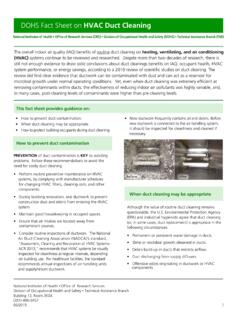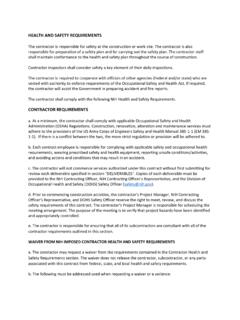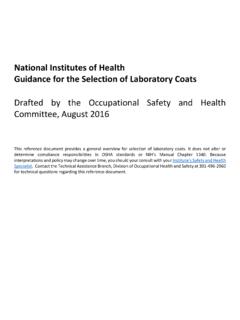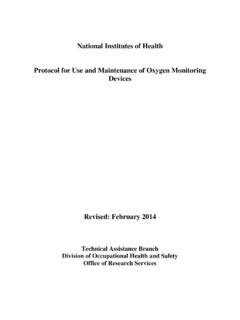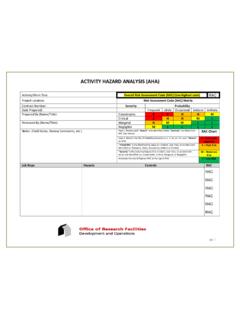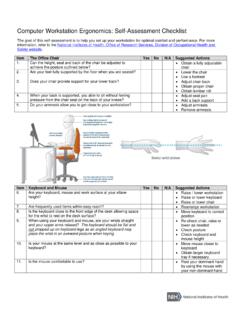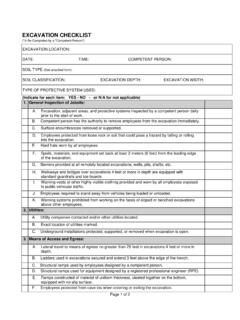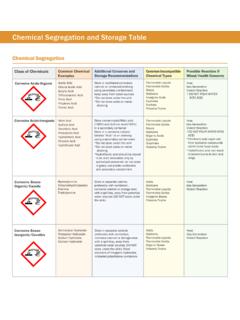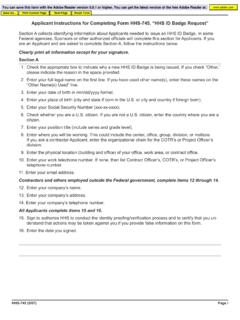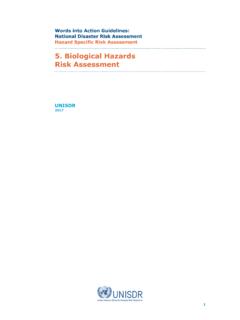Transcription of NIH Chemical Hygiene Plan
1 National Institutes of Health Chemical Hygiene Plan 2018 Authored by the Division of Occupational Health and Safety (DOHS) and the Occupational Safety and Health Committee (OSHC). Plan revisions were reviewed during the OSHC meeting on 9/13/2017. Edits and comments from OSHC members following the meeting were incorporated. CONTENTS 2 I. 2 II. 3 III. RESPONSIBILITIES .. 3 IV. 5 V. LABELS AND SAFETY DATA 5 VI. Chemical TRANSPORTATION .. 6 VII. CONTROL OF EXPOSURE TO HAZARDOUS 7 VIII.
2 Chemical STORAGE IN THE LABORATORY .. 11 IX. PERSONAL PROTECTIVE EQUIPMENT .. 11 X. WORKING WITH PARTICULARLY HAZARDOUS 13 XI. PRECAUTIONS REQUIRED FOR WORKING WITH PARTICULARLY HAZARDOUS 14 XII. MEDICAL CONSULTATION AND MEDICAL 16 XIII. Chemical Hygiene PLAN EVALUATION AND RECORD KEEPING .. 16 APPENDIX A -General 17 APPENDIX B - Guidance for Identifying Particularly Hazardous 20 APPENDIX C - Employee Training and 28 APPENDIX D - Proper Storage of Chemicals in the 29 Table 1 Chemical Segregation and Storage 32 National Institutes of Health | 2018 Table 2 - Suggested Storage Time limits for Common Peroxide Forming Compounds.
3 33 APPENDIX E - Selection of 35 APPENDIX F - Glossary of 38 APPENDIX G - Hazardous Material Spill 44 APPENDIX H - General Decontamination 49 APPENDIX I - Michael Gottesman Memo Laboratory Safety Responsibilities 50 APPENDIX J - Laboratory Hazard 51 APPENDIX K - Laboratory Personnel Safety Check 52 National Institutes of Health | 2018 ACRONYMS ACGIH American Conference of Governmental Industrial Hygienists ANSI American National Standards Institute BSC biological Safety Cabinets CFH Chemical Fume Hood CFR Code of Federal Regulations CHO Chemical Hygiene Officer CHP Chemical Hygiene Plan DEP Division of Environmental Protection DOHS Division of Occupational Health and Safety DRS Division of Radiation Safety GHS Globally Harmonized System of Classification and Labeling of Chemicals IARC International Agency for Research on Cancer IC Institutes and Centers LEV Local Exhaust Ventilation Systems NIH National Institutes of Health NTP National Toxicology Program OMS Occupational Medical Service ORF Office of Research Facilities
4 Development and Operations ORS Office of Research Services OSHA Occupational Safety and Health Administration OSHC Occupational Safety and Health Committee PEL Permissible Exposure Limit PI Principal Investigator PHS Particularly Hazardous Substance PPE Personal Protective Equipment SDS Safety Data Sheet TAB Technical Assistance Branch TLV Threshold Limit Value published by ACGIH TOXNET Toxicology Data Network TWA Time Weighted Average National Institutes of Health | 2018 | 1 INTRODUCTION The use of hazardous chemicals in the laboratory is a necessary part of modern biomedical research.
5 To ensure the protection of laboratory personnel from the risks associated with the use of hazardous chemicals, the Occupational Safety and Health Administration (OSHA) has promulgated a standard entitled Occupational Exposures to Hazardous Chemicals in Laboratories (29 CFR ), referred to as the Laboratory Standard. Traditionally, OSHA health standards have been established to help protect industrial and manufacturing workers who may be exposed to significant quantities of hazardous chemicals over a working lifetime. In contrast, the use of hazardous chemicals in research laboratories is generally limited to small quantities used on a short-term basis and in operations where the chemicals and procedures change frequently.
6 The Laboratory Standard demonstrates that OSHA has recognized the need for a standard that focuses on the unique nature of laboratory work. The Laboratory Standard requires the development and implementation of a formal, written, and employee-accessible program, referred to as a Chemical Hygiene Plan (CHP). This plan, as defined by OSHA, must be capable of protecting employees from health hazards associated with hazardous chemicals used in the laboratory. The Laboratory Standard complements the provisions of the OSHA Hazard Communication Standard (29 CFR ). In accordance with the Hazard Communication Standard, the NIH has established a written program, the NIH Hazard Communication Program for the use of hazardous chemicals outside of the laboratory.
7 The NIH CHP is written specifically for the laboratory environment. Additionally, this laboratory standard supersedes the provisions of all other OSHA health standards found in 1910 Subpart Z, with the following exceptions: for the permissible exposure limits (PELs) and substance-specific limits found within the OSHA Air Contaminants Standard (29 CFR ) in Subpart Z, Toxic and Hazardous Substances as well as the prohibition of eye and skin contact where specified by any OSHA health standard. I. PURPOSE This plan outlines the information and services provided by the Division of Occupational Health and Safety (DOHS), Office of Research Services (ORS) and the Division of Environmental Protection (DEP), Office of Research Facilities Development and Operations (ORF) on the safe use, storage, and disposal of hazardous chemicals in the laboratory.
8 This program is written to meet the specific safety and health requirements outlined in 29 CFR , Occupational Exposure to Hazardous Chemicals in Laboratories. National Institutes of Health | 2018 | 2 II. SCOPE This plan applies to all laboratories and laboratory personnel of the NIH that use, store, or handle hazardous chemicals. A hazardous Chemical is defined as a substance which presents a physical hazard and/or has one or more properties for which there is statistically significant evidence that acute or chronic health effects may occur in exposed individuals.
9 Health effect categories of chemicals include, but are not limited to, carcinogens, toxic or highly toxic agents, reproductive toxins, irritants, sensitizers, hepatotoxins, nephrotoxins, neurotoxins, agents which act on the hematopoietic systems and agents which damage the lungs, skin, eyes, or mucus membranes. Physical hazards include, but are not limited to, chemicals which are explosive, flammable, or corrosive. (Definition listed in Appendix F Glossary of Terms. ) III. RESPONSIBILITIES The Chemical Hygiene Officer (CHO) when requested by a laboratory representative, is responsible for assisting with obtaining Safety Data Sheets (SDSs) for hazardous chemicals, working with laboratories to determine exposure possibilities, arranging for exposure monitoring, and implementing the CHP.
10 The CHO assists the OSHC with updating the CHP annually. The NIH Occupational Safety and Health Committee (OSHC) is responsible for reviewing and evaluating the effectiveness of the CHP yearly and updating the plan as necessary. The DOHS Safety and Occupational Health Specialists assist laboratory personnel in matters relating to Chemical safety and exposure monitoring. Upon request, they review safety protocols for work involving hazardous chemicals to ensure that the proposed activities are conducted by trained personnel using the proper safety equipment and personal protective equipment (PPE). They conduct surveys of select laboratories to identify practices or procedures that may pose potential hazards to the health and safety of personnel.
